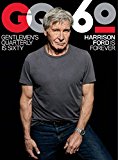 If you want to write for men’s magazines you need to appreciate how they are understood and consumed by their target readership. I asked Gareth Longstaff, media lecturer at Newcastle University, to give us the low-down on men’s mags. Gareth is currently completing his PhD in the representation of male sexuality in the media and visual culture. He is a feature writer and columnist for several commercial magazines including The Crack, Gay Times, OUT and iD.
If you want to write for men’s magazines you need to appreciate how they are understood and consumed by their target readership. I asked Gareth Longstaff, media lecturer at Newcastle University, to give us the low-down on men’s mags. Gareth is currently completing his PhD in the representation of male sexuality in the media and visual culture. He is a feature writer and columnist for several commercial magazines including The Crack, Gay Times, OUT and iD.
How do you men actually read a ‘men’s magazine’ and just what is the market for male readers in 2010? Asking myself this question I gradually realised the nature of actually being a man has a lot to answer for here, as well as the ways in which so called ‘identity politics’ have fragmented and disrupted the very nature of masculinity and its once dominant presence in mass popular culture.
In these days of niche markets and sub-sub-cultures you most certainly have to be defined or targeted as a particular type of reader before you even pick up the latest copy of this or that, and on page after page your own desires and anxieties as that reader are satisfyingly relayed back to you. Or are they?
Case study 1 – yours truly! – I am 31, white, largely middle/professional class in terms of job, flat, and the car I drive and to add insult to injury when I sift through the piles of magazines that seem to gather next to my loo or by the side of my sofa that identity is reinforced for me.
GQ, Esquire, Men’s Health and the occasional copy of Attitude or GT (the old title of Gay Times deemed to be just too ‘Gay’ these days!) give me back all that I seem to want out of life, love and happiness when it is branded, advertised and airbrushed. The reiteration and reinforcement of all that is stereotypically ‘me’ effortlessly sounds out page after page and it’s hard to resist the latest commodity that would either look great in my flat or even better on me.
I am also part of that demographic of men who are safe and appealing to the market because we buy, and there is nothing better than a savvy yet simultaneously seducible male consumer to keep the capitalist barometer going. I am also led into believing that I am unique, that this latest bottle of Tom Ford encapsulates who I am or that I really need a Paul Smith dressing gown and once again my role and my purpose is neatly contained and sustained for me. Phew, rant (almost) over but hopefully point conveyed!
But what of the men’s magazines that do not speak to me? The ones I see arrogantly and seamlessly standing on the shelves of WH Smith’s but intentionally turn away from because they are too blatant, too laddish and let’s face it, just too degrading to women. The cheaply produced weekly ordeals in boobs, football and extreme injuries or activities in far-off (their words not mine!) uncivilised lands sell like hotcakes and the ways in which men are addressed could not be further away from the fashion and lifestyle-based stuff I consume.
But maybe that’s the key: the construction and aspiration for a ‘lifestyle’ or rather ‘lifestyles’ that can be viewed and manipulated from a distance. Men’s magazines (in fact all magazines) are just like pornography; they don’t answer back, they don’t laugh at you, they momentarily satisfy until the next desire comes along.
So what’s going on here? Not everyone draws out the same thing from the magazines that they buy and if they did the world would be incredibly banal, so looking again I tried to unpick what unites these very different sorts of men’s magazines and the place I got back to was not identity, not lifestyle but sex!
Thinking and looking – again the objectification of women and more blatantly men in the gay publications – the assumption that readers are gendered and sexualised in a particular way seems to haunt each and every representation, article, photograph. Whilst social, economic and political roles and contexts have shifted we still as men, and probably more so as women, live with the problematic fact that ‘Sex Sells’!

I have a sneaking suspicion that almost exactly the same article could be written about women’s magazines — including being degrading to women (how many women’s magazines obsess about body image?) And certainly “the assumption that readers are gendered and sexualised in a particular way seems to haunt each and every representation, article, photograph”.
I think you’re right, Tim!
This posthelped me a lot in my school work. I am writing a paper on a similar topic. I was feeling kinda lost, but it seems I gotwhat I was searching forand I’m on the right path now. thanks a million!
I’ll let Gareth know. Glad it helped, Hayden.